Bring home a taste of Hawaii with this oh-so-delicious Butter Mochi! Made with coconut milk and mochiko (glutinous rice flour), this classic Hawaiian sweet treat will have everyone drooling. You’ll love the chewy, buttery texture and tropical flavor of this dessert that’s part Japanese mochi and part local coconut cake. It’s so simple to make and perfect for your next potluck party or family get-together.
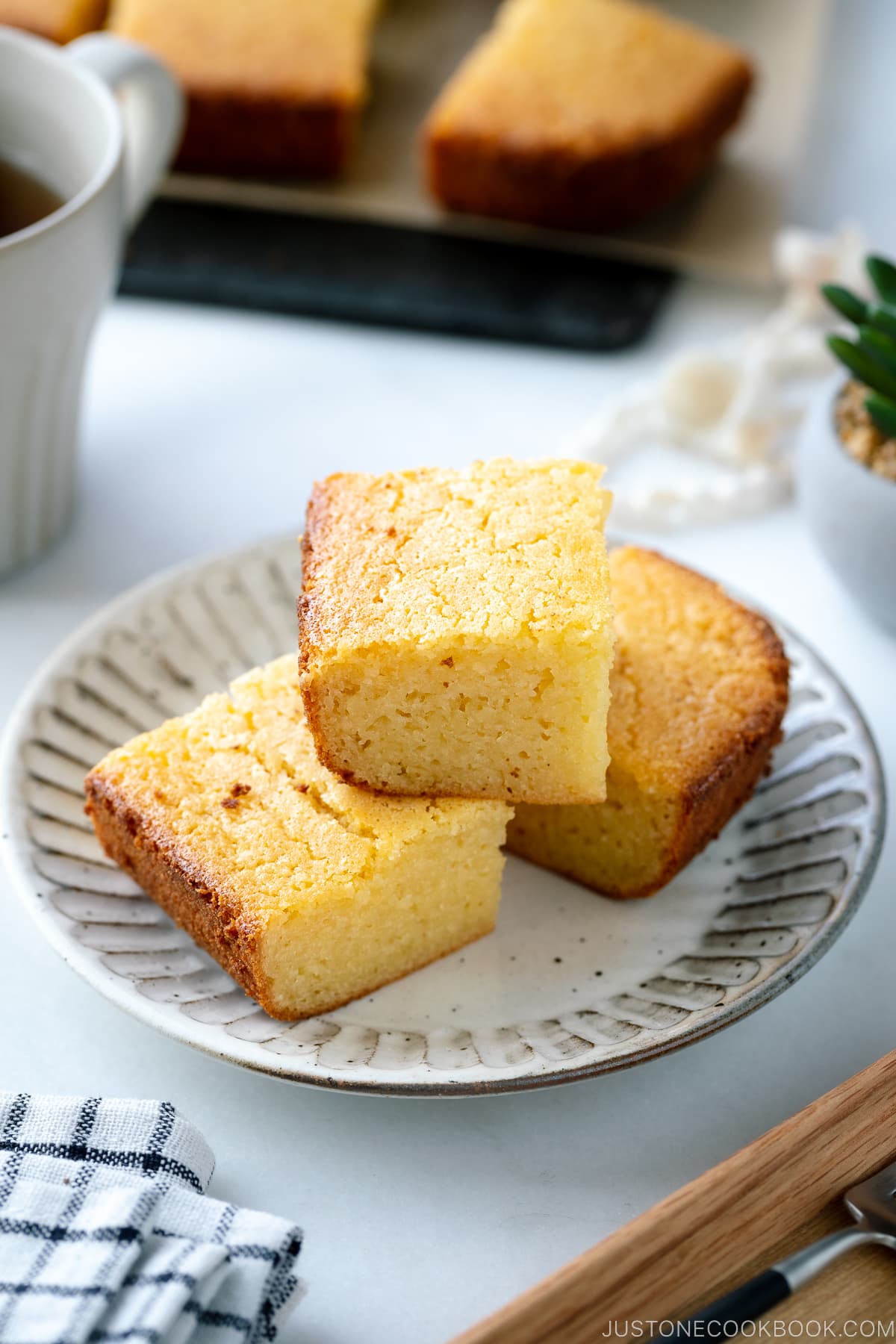
Crisp caramelized edges, chewy and gooey in the middle with fragrant coconut flavor, butter mochi is one of the most popular desserts in Hawaii. It’s a sort of hybrid dessert combining Japanese mochi with local coconut cake.
My family has enjoyed our fair share of butter mochi—from Shueido, a Japanese confectionery store in San Jose, to souvenirs from Hawaii to Naomi’s homemade one (she’s a JOC team member). Today I’m sharing our family’s favorite version. It’s rich but not too sweet with subtle hints of vanilla, butter, and coconut. The interior is wonderfully chewy and the crust is addictively crispy.
If you love a sweet treat and all things mochi, you have to make this!
Table of Contents
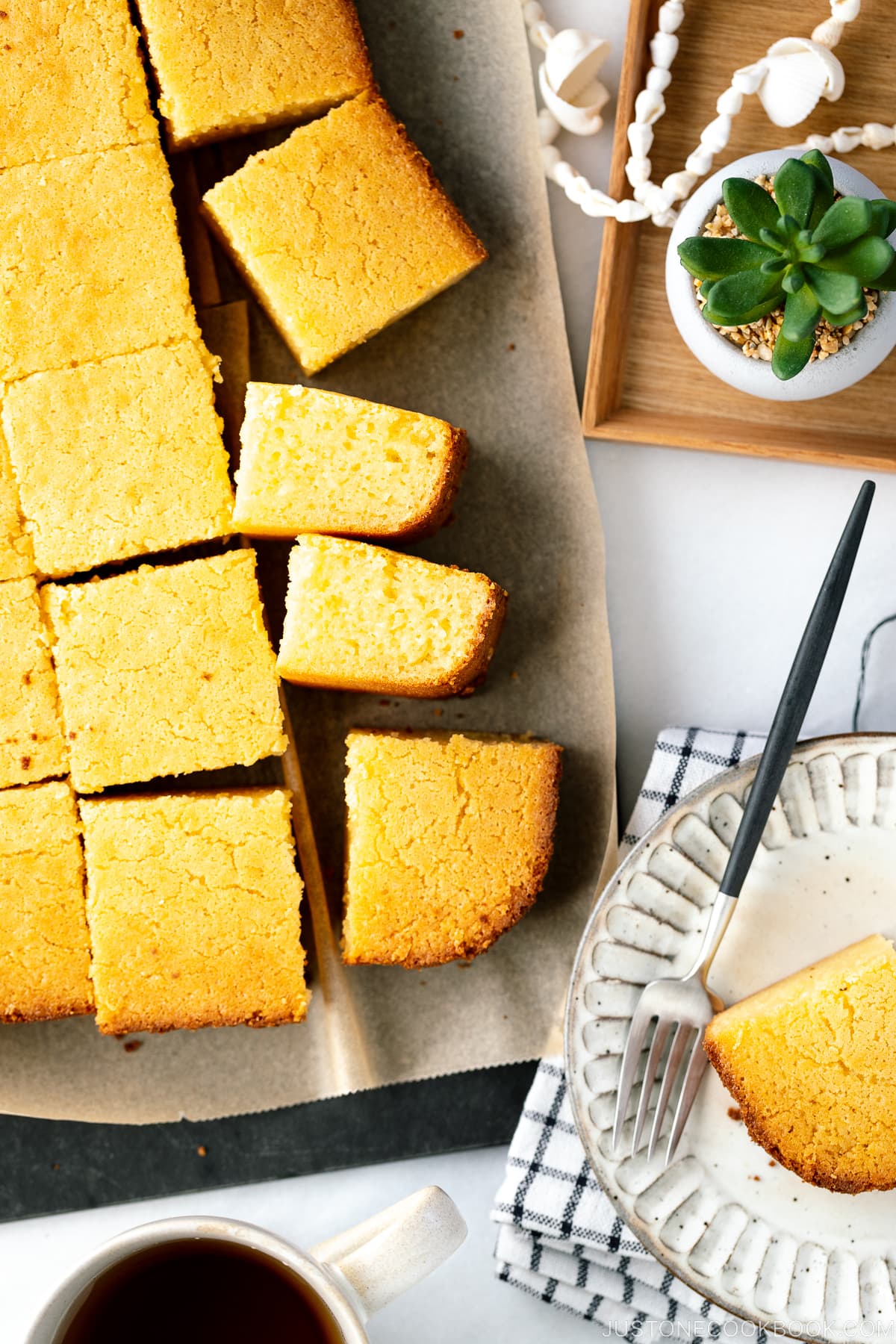
What is Butter Mochi?
Butter mochi is a favorite local Hawaiian sweet made of butter, mochiko flour, coconut milk and some kind of other milk (evaporated or whole milk). It’s pretty much a coconut custard glutinous rice cake that is chewy and slightly sticky on the inside and crispy on the outside. Baked in a pan and cut into squares, butter mochi may look plain but it’s a true staple dessert in Hawaii. The locals would serve it at potlucks, parties, or any gatherings.
Like many things in Hawaii, it can be difficult to trace the exact origins of butter mochi, but it is certainly a result of many layers of cultural influences. Some claim that it is based on a bibingka, a Filipino coconut rice cake, and another popular Hawaiian sweet, chichi dango (乳団子), which was originally from Hiroshima.
Butter mochi started getting more popular even outside of Hawaii, and now you can find a pre-mix box version at Trader Joe’s in the US. It’s a simple dessert but that’s the allure of it.
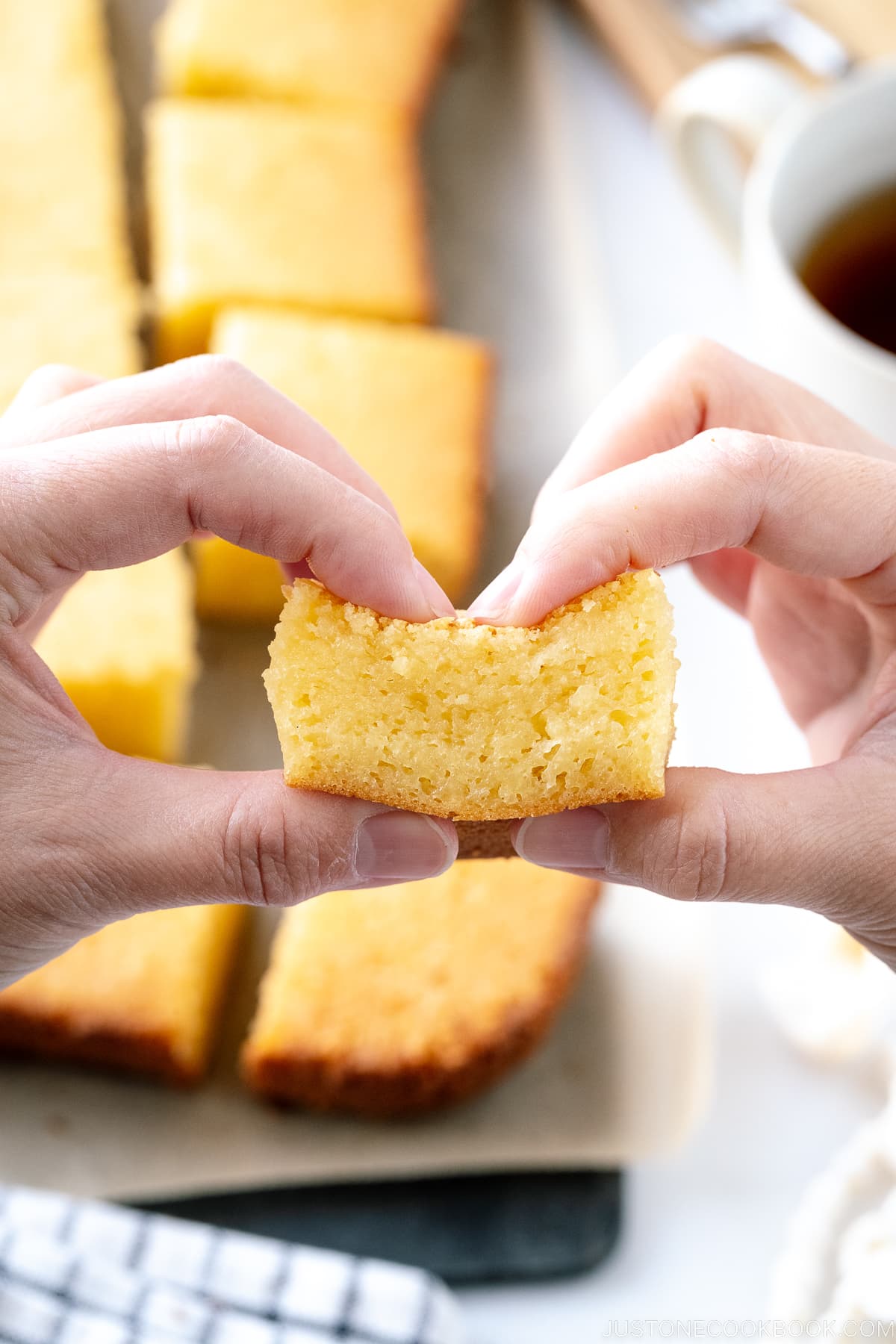
The Recipe Inspiration
Since butter mochi is not something I grew up eating, I had to do a bit of tinkering to achieve the perfect one that gets the final votes from my family. I started by researching online and creating a spreadsheet to compare everyone’s ingredients, just like how I did with my Furikake Chex Mix.
Soon I realized that all the top ten recipes have the same ingredients with a slight difference in amount, so it was all about finding the right ratios that suit our taste. I think my kids loved this recipe testing stage more than any other tests I’ve done. After I’ve done 8 different trials in total, we all agree this final version was the best. Luckily, my neighbors enjoyed the multiple butter mochi drop-offs.
You’d find that most recipes say it only last for 3 days, but I’ve also tested freezing my butter mochi and it tastes just as amazing after defrosting and microwaving to warm it up a little.
Just like any other home cooking, it’s really up to you how you and your family enjoy it. Experiment with what you like, and use the recipe I share today as a base and adjust from there.
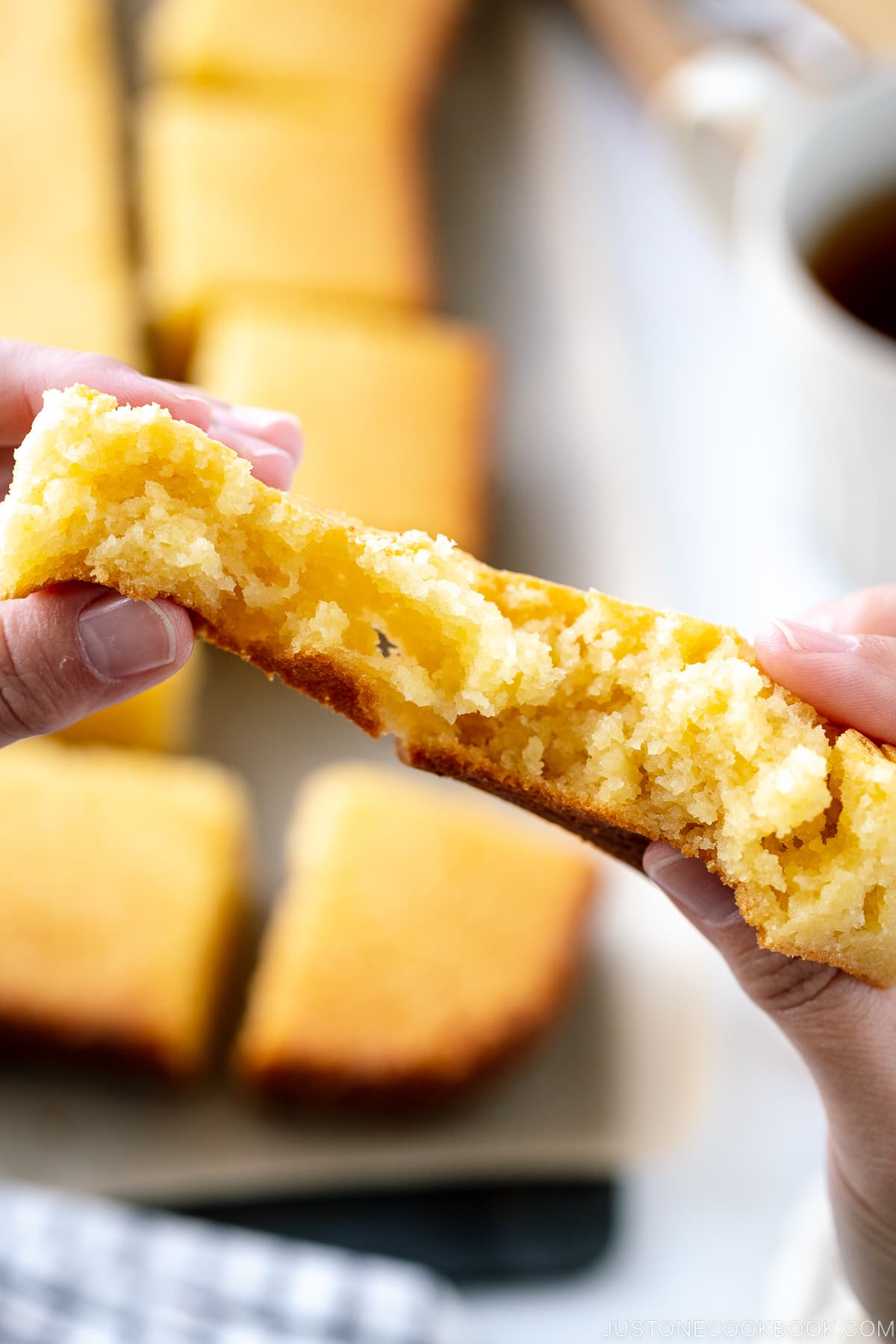
How to Make Butter Mochi
Ingredients You’ll Need
- Unsalted butter
- Mochiko (glutinous rice flour) – I’ll talk more about this ingredient below.
- Baking powder
- Salt
- Eggs
- Sugar
- Unsweetened coconut milk
- Evaporated milk
- Vanilla extract
As you see above, ingredients for this recipe are all pantry-friendly. If you have butter and eggs, you can make this any time! If you have an unexpected guest over, butter mochi is a great dessert to make, especially when you serve it warm.
Overview: Cooking Steps
- Preheat the oven, grease the baking pan, and melt the butter in the microwave.
- Mix all the ingredients (I used my stand mixer, but you can hand-whisk).
- Pour the batter into the baking pan.
- Bake at 375ºF for 45 minutes.
- Let cool slightly, cut into pieces, and enjoy!
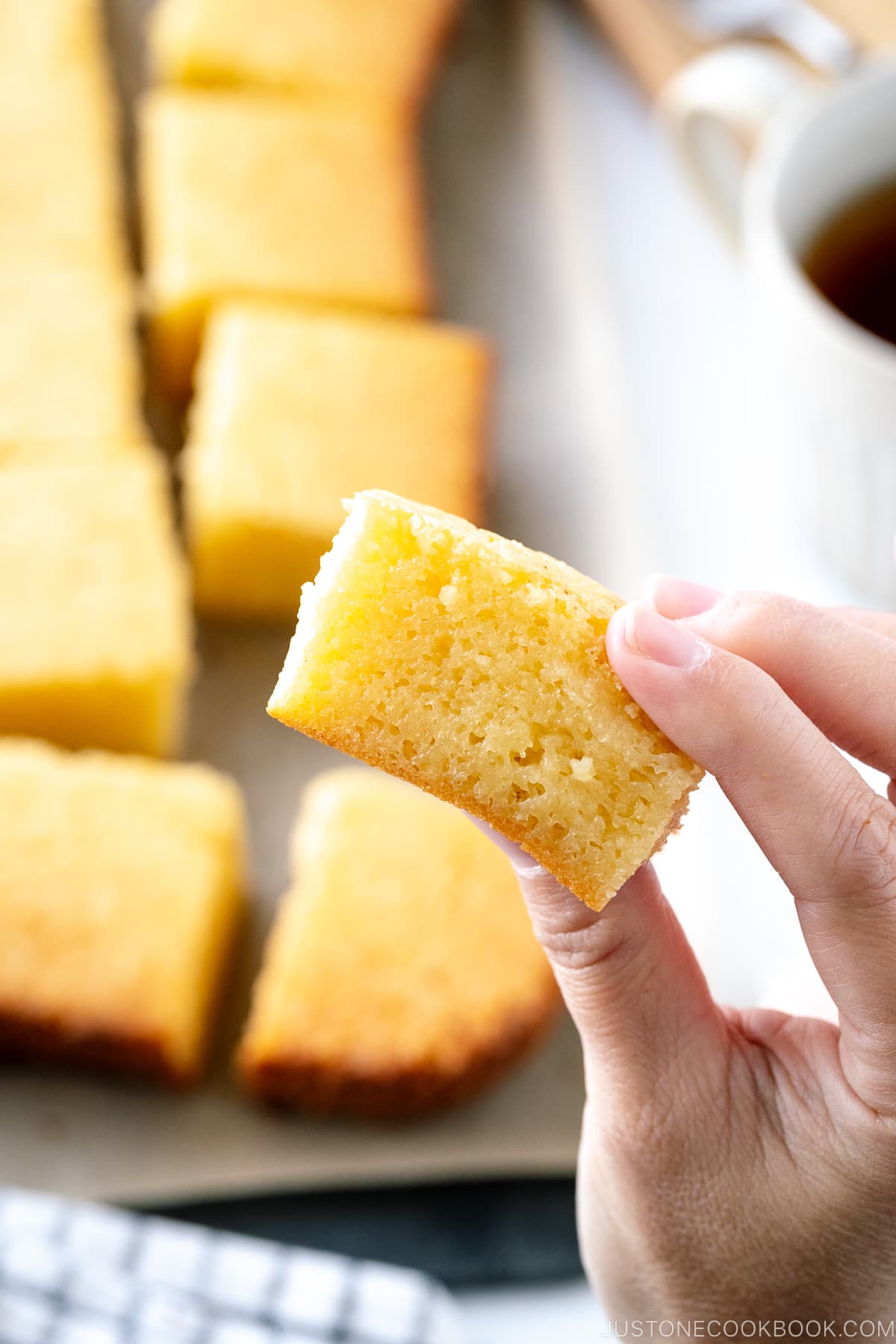
What is Mochiko?
Mochiko (餅粉, もちこ) is a fine white gluten-free flour made of glutinous/sweet rice. It’s an ingredient in wagashi (Japanese traditional sweets), such as daifuku mochi, yatsuhashi, senbei rice crackers, and dango.
It’s also used in Korean desserts, Filipino bibingka-style confections, and some Chinese dim sum dumplings. In Hawaiian cuisine, it’s used as a coating for mochiko chicken, butter mochi, chi-chi-dango, and cakes.
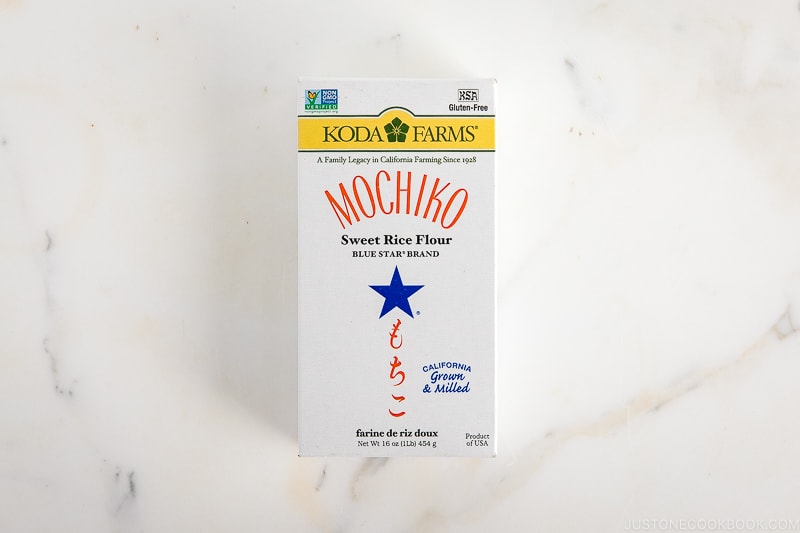
Mochiko from Koda Farms is most well-known product in the U.S. and can be found in Japanese, Asian, and well-stocked American grocery stores.
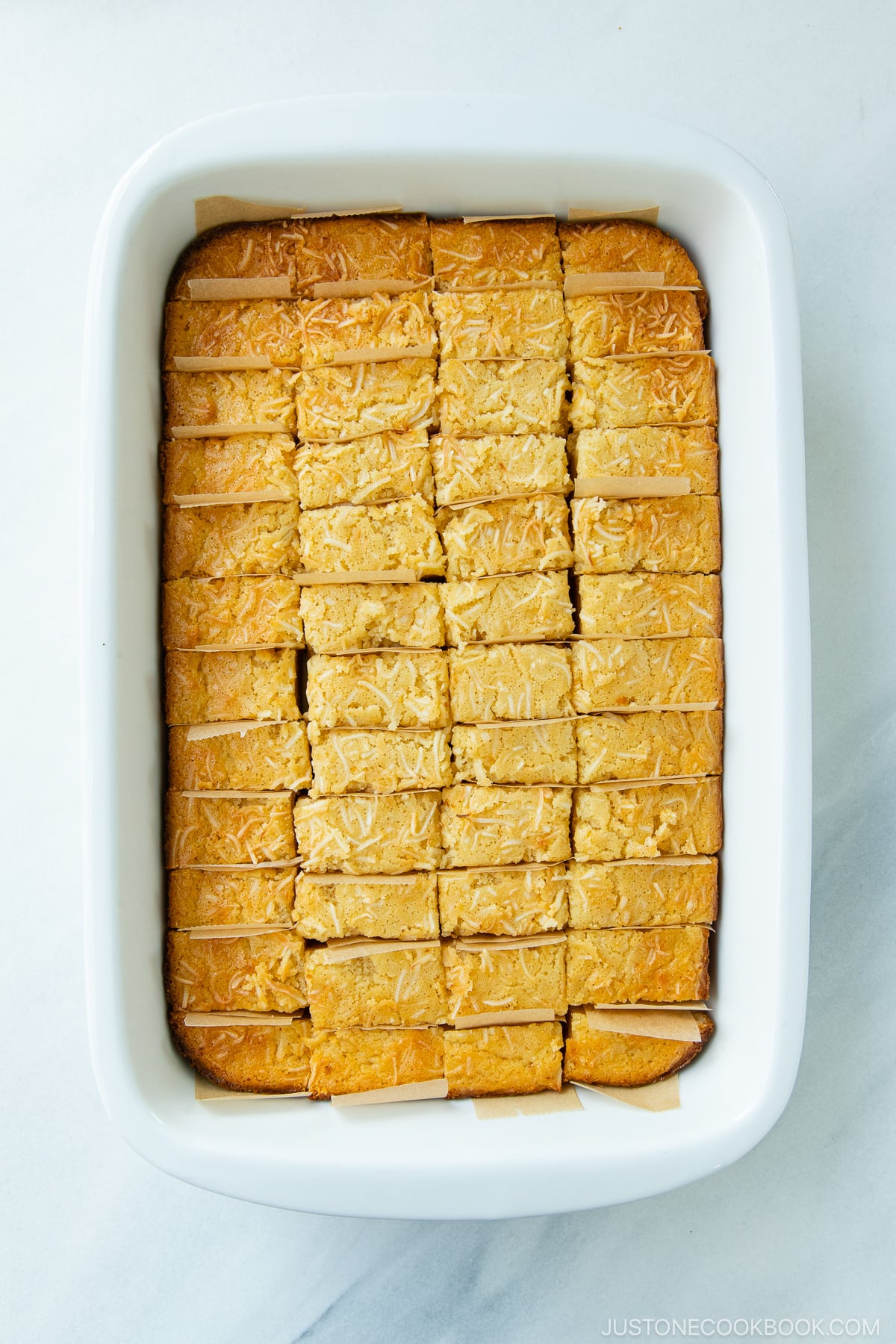
Butter Mochi Toppings
I highly recommend sprinkling unsweetened coconut flakes on top of the batter before baking. You could also add them to the batter and mix them all up.
Butter Mochi Tips
- Thoroughly grease the baking pan. This will help to achieve clean-cut pieces when you slice the cake. I love the buttery crispy crust (they are all mine!) so I take it seriously. If the butter wrapping has some residual butter, use it to grease the pan. You can also use the leftover in the bowl/measuring cup after melting the butter for greasing. No waste!
- Mix until no lumps! No need to worry about overmixing! Since mochiko (glutinous rice flour) is not wheat flour, we don’t have to worry about overmixing this batter.
- For crispy edges and a chewy center, bake at 375ºF (190ºC) for 45 minutes. I should mention that every oven is different (size, gas/electric, etc), so you may want to test and adjust. A lot of recipes online suggest baking at 350ºF (177ºC) while only a few suggest 375ºF. I personally like to bake mine at 375ºF for 45 minutes for crispy edges and a chewy center. Make sure an inserted skewer comes out clean.
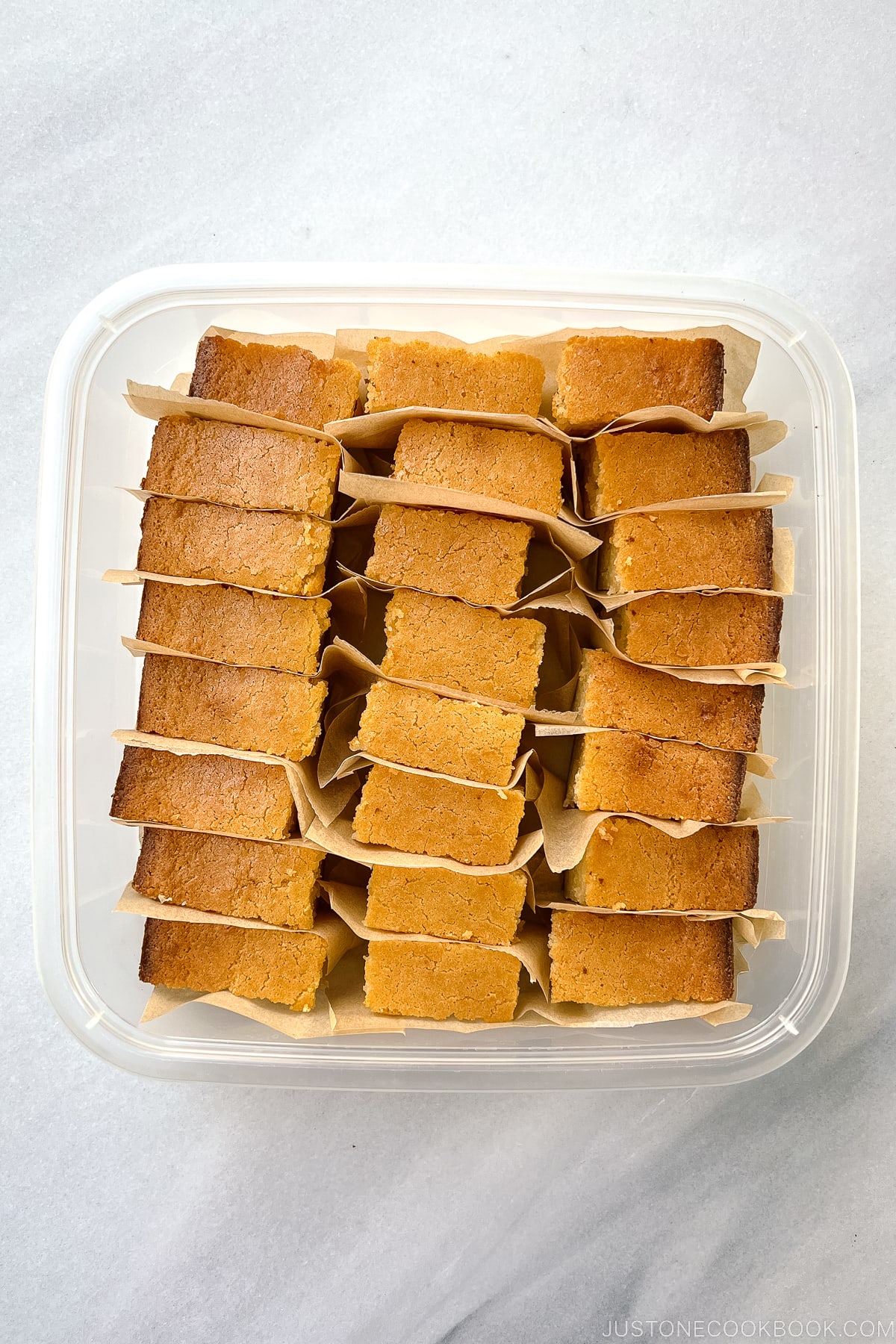
FAQs
Can I make this recipe in two 8×8-inch baking pans?
Yes, you can either use two 8×8-inch baking pans or cut the recipe ingredients in half to make one 8×8-inch baking pan.
How can I make a small portion?
I know you’d ask because I used to think the same!
I used to make one 8×8-inch pan. Then, I realized that I preferred to empty out the entire box of mochiko and two cans (coconut and evaporated milk) instead of keeping the half. I don’t use these ingredients for other recipes. If you do, please feel free to make half portion!
So for those of you who feel this portion is too much, may I suggest:
- Give half of freshly baked butter mochi to neighbors, friends, and family. They will love you and wait for your next delivery of butter mochi!
- Enjoy the quarter for yourself and family (next 3 days).
- Freeze the rest when the butter mochi is completely cooled. See below.
Can I freeze the butter mochi?
Yes, I highly recommend freezing on day 1 (don’t wait till day 3) while the butter mochi is fresh!
Wrap each piece in plastic to avoid freezer burn, drying, and sticking. Then, place them in a freezer bag or airtight container and freeze them for up to 1 month (for better taste) to 2 months (I think it still tastes ok).
Thaw overnight in the refrigerator or at room temperature. Microwave for 5-10 seconds before serving.
I miss eating butter mochi once in a while. It’s really nice to be able to enjoy a few pieces with my afternoon tea!
Can I use other types of milk instead of evaporated milk?
Yes! As I explained in my post earlier, many recipes online use whole or reduced milk to make butter mochi instead of evaporated milk. Evaporated milk makes the batter creamier and thicker than regular whole milk. We don’t keep whole milk in my house so I like using evaporated milk for this recipe as I can keep one can of both evaporated milk and coconut milk in my pantry all the time, and when I feel like I want to make butter mochi, I can quickly make it.
If you’re from Hawaii and have a family recipe that you’d like to share, please do so in the comment below.
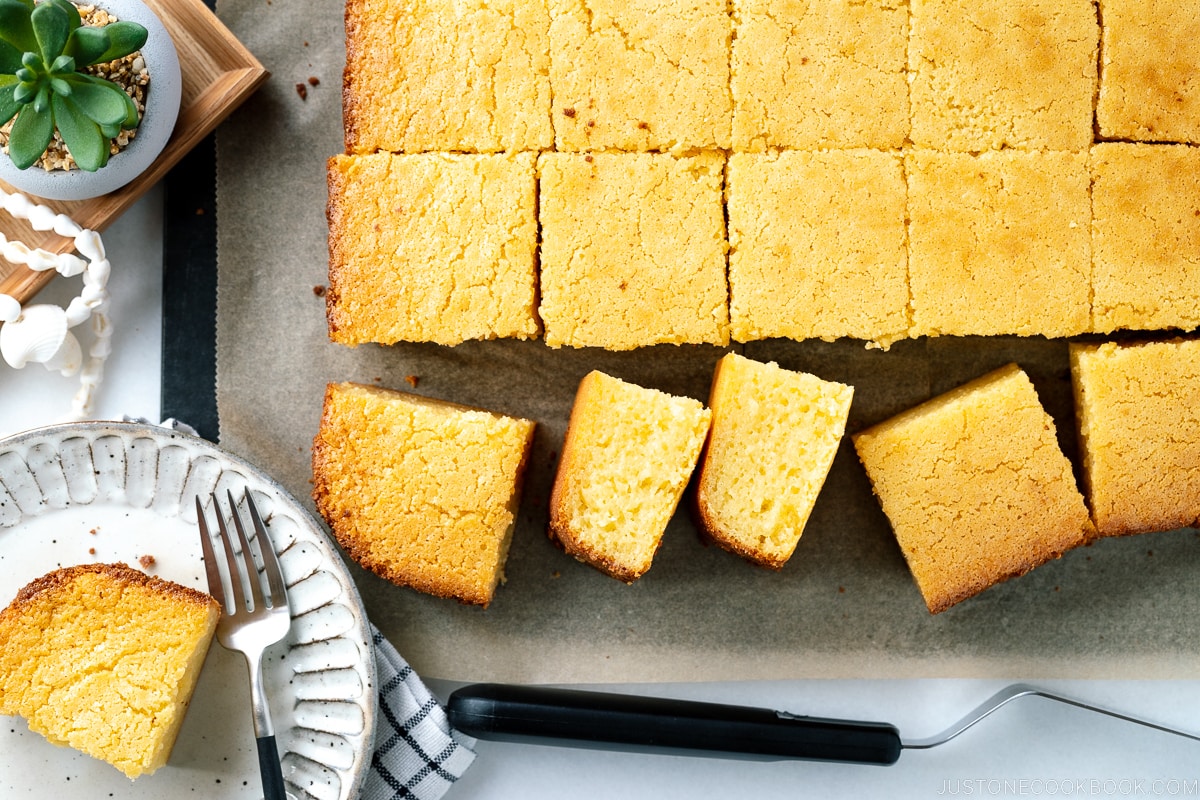
Wish to learn more about Japanese cooking? Sign up for our free newsletter to receive cooking tips & recipe updates! And stay in touch with me on Facebook, Pinterest, YouTube, and Instagram.
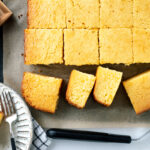
Butter Mochi
Video
Ingredients
- ½ cup unsalted butter (1 stick; plus more for greasing the pan)
- 1 lb mochiko (glutinous rice flour/sweet rice flour) (1 box Koda Farms brand)
- 1½ tsp baking powder (use 1 tsp for a slightly less fluffy version)
- ½ tsp Diamond Crystal kosher salt
- 4 large eggs (50 g each w/o shell)
- 2 cups sugar
- 1 (13½-oz) can unsweetened coconut milk
- 1 (12-oz) can evaporated milk
- 2 tsp pure vanilla extract
Instructions
- Gather all the ingredients. Arrange a rack in the middle of the oven and preheat the oven to 375ºF (190ºC). For a convection oven, reduce the cooking temperature by 25ºF (15ºC).
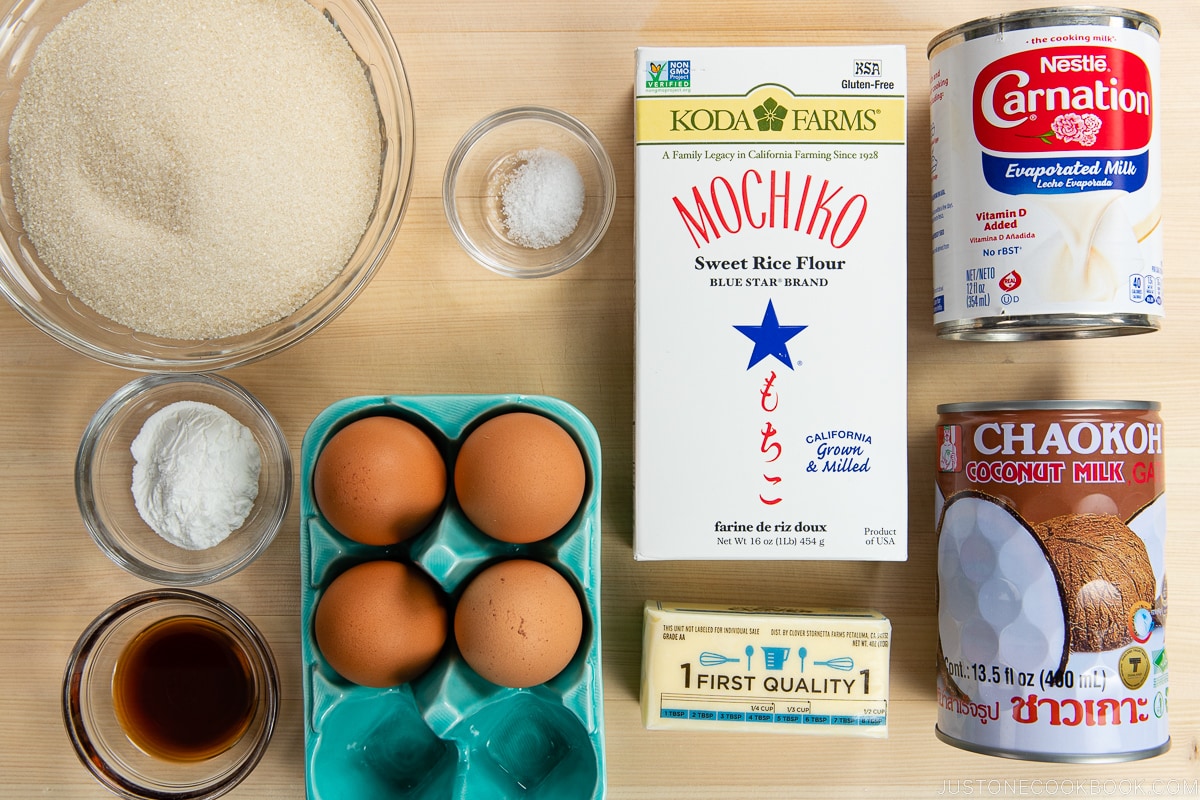
- First, melt ½ cup unsalted butter: Place the butter in a liquid measuring cup and microwave for 60–70 seconds (W1000). Alternatively, you can melt it in a pot on the stovetop. Set the melted butter aside. Keep the butter wrapper for the next step.
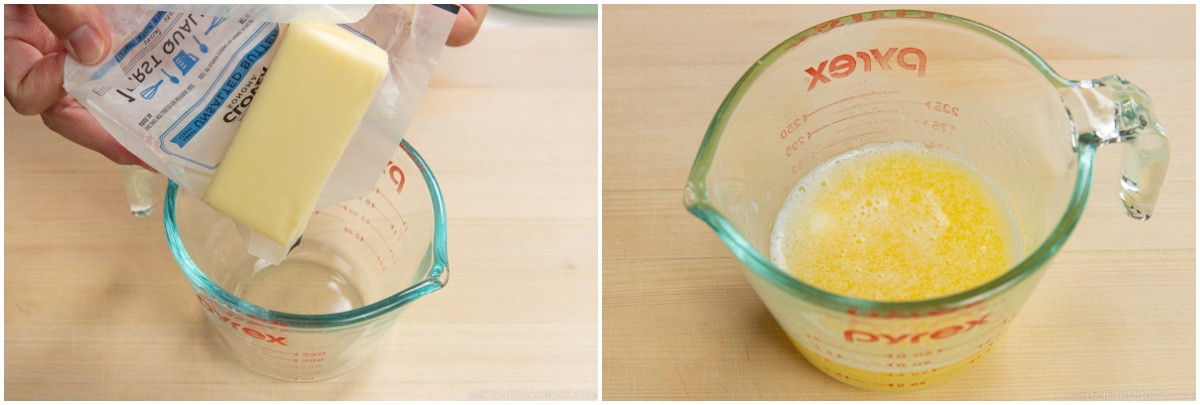
- For one batch, grease a 9 x 13-inch baking pan (or two 8 x 8 x 2-inch pans) with the butter left on the wrapper; you also can use neutral-flavored oil, if you‘d like. I use the leftover butter on the wrapper first, then use additional butter if needed. Later, once you pour the melted butter into the batter, you also can use the leftover butter in the measuring cup to grease the pan with a pastry brush.
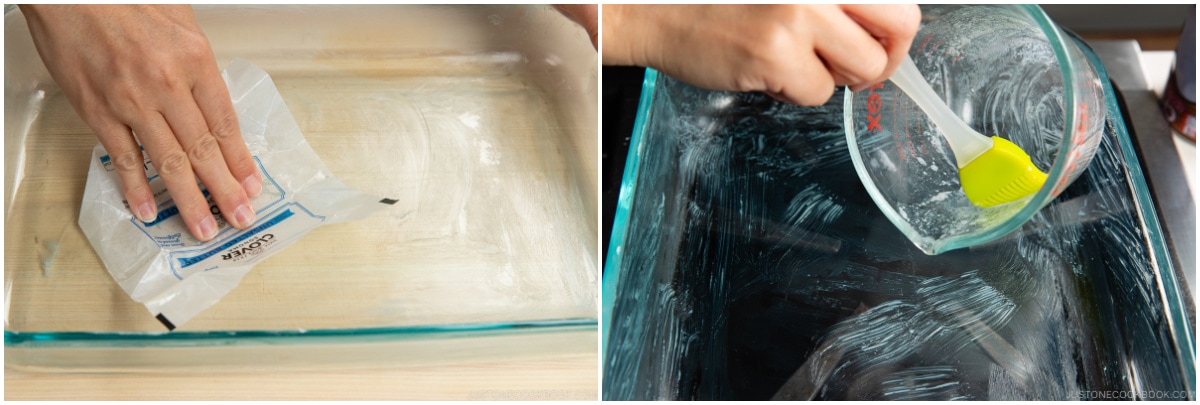
To Make the Batter
- In a medium bowl, combine 1 lb mochiko (glutinous rice flour/sweet rice flour), 1½ tsp baking powder, and ½ tsp Diamond Crystal kosher salt and whisk to combine. It‘s important to equally distribute the baking powder and salt into the mochiko flour. Set it aside.
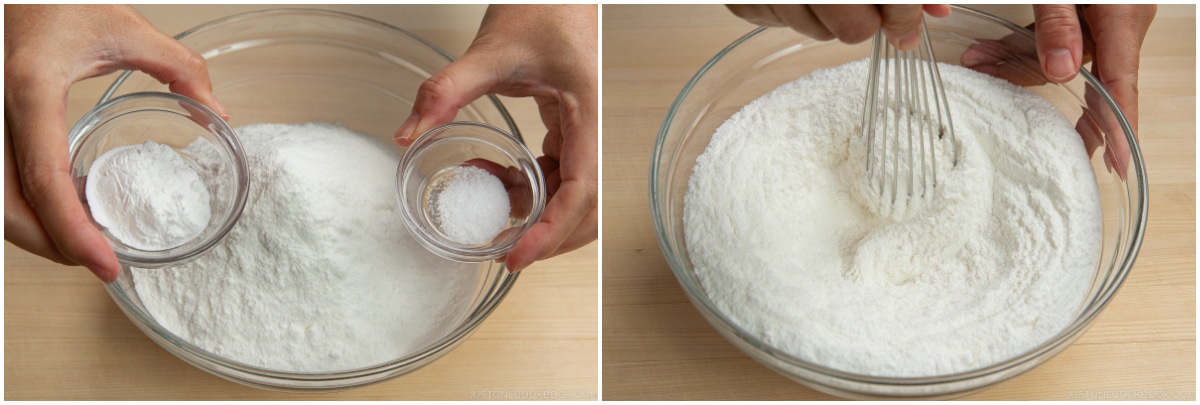
- In a stand mixer bowl or a large bowl, crack 4 large eggs (50 g each w/o shell) and add 2 cups sugar. Tip: You will stir the batter at low speed (Speed 2 on the stand mixer), so you can use a hand whisk, electric hand mixer, or stand mixer for this job.
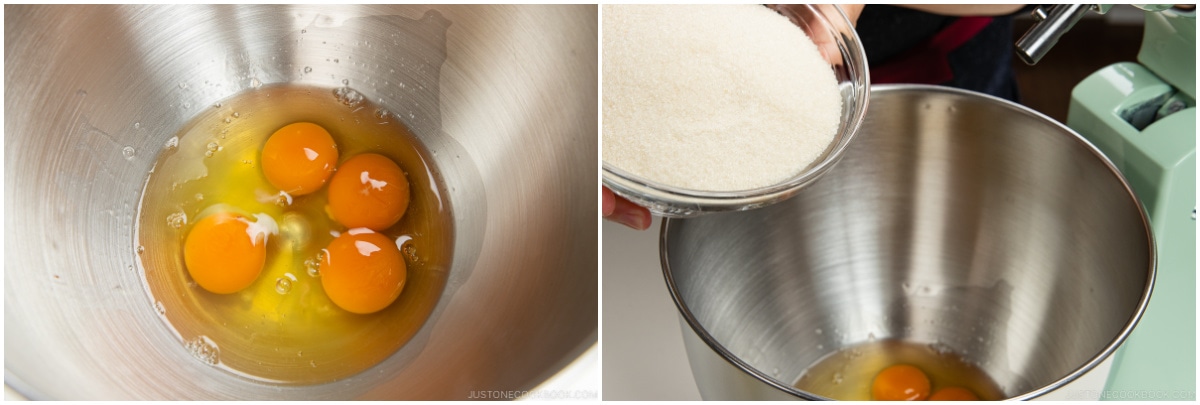
- Whisk at low speed (by hand or on mixer Speed 2) the eggs and sugar together until creamy.
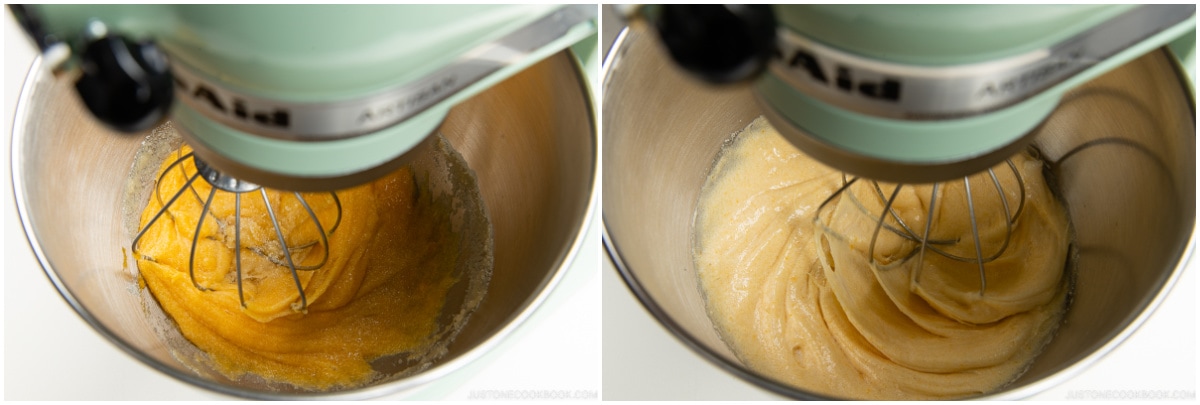
- Add 1 (13½-oz) can unsweetened coconut milk and stir to combine.
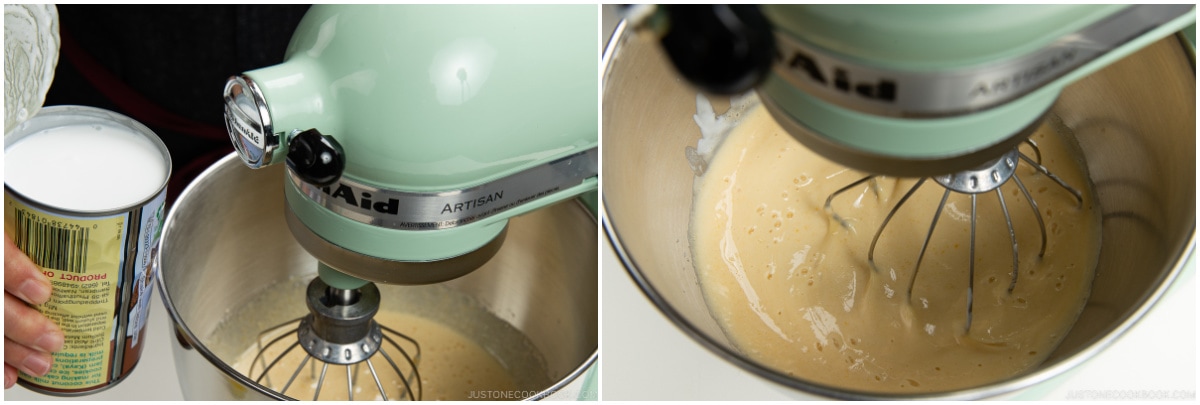
- Add 1 (12-oz) can evaporated milk and stir to combine.
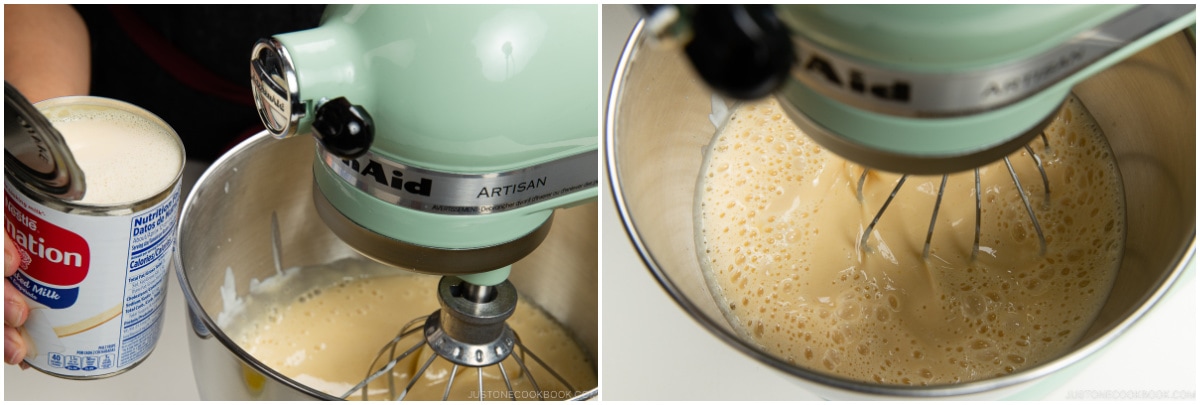
- Add 2 tsp pure vanilla extract and mix. Then, slowly add the melted butter to the mixture while mixing.
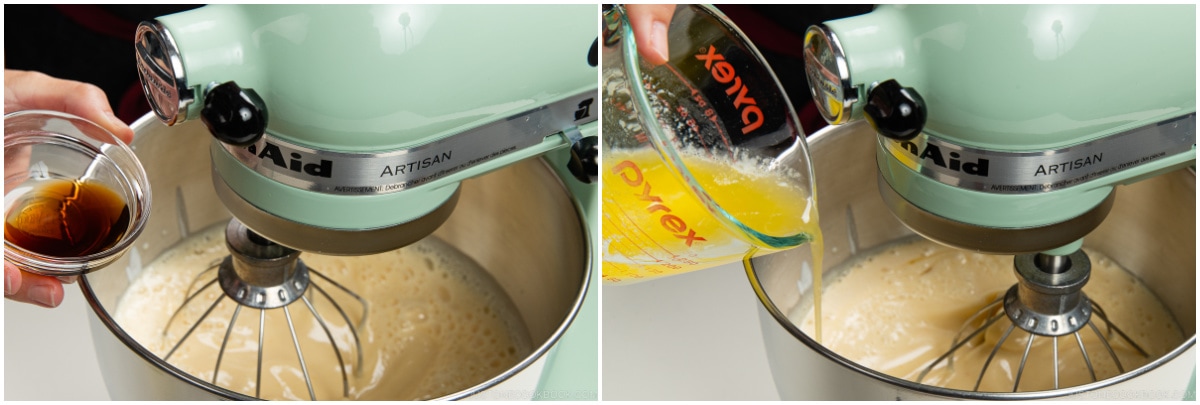
- Whisk well to combine everything.
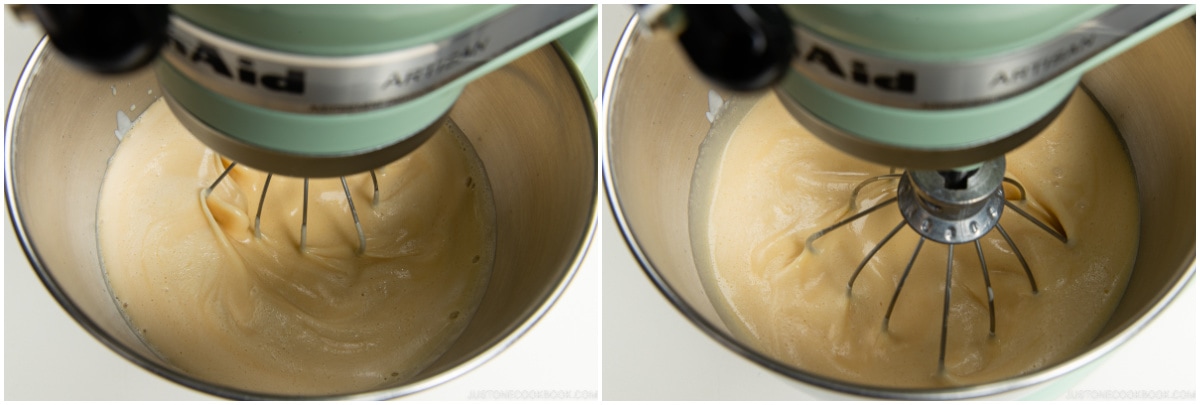
- Next, add the dry ingredients all at once to the mixing bowl and whisk to incorporate everything.
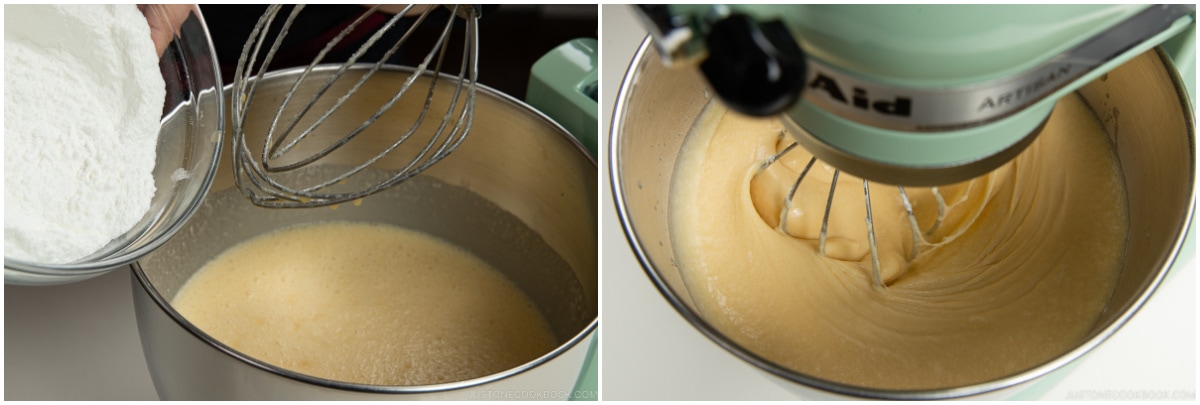
- Stop mixing and scrape down the sides and bottom of the bowl with a silicone spatula to make sure there are no lumps. Then, start mixing again until the batter is homogeneous and smooth.
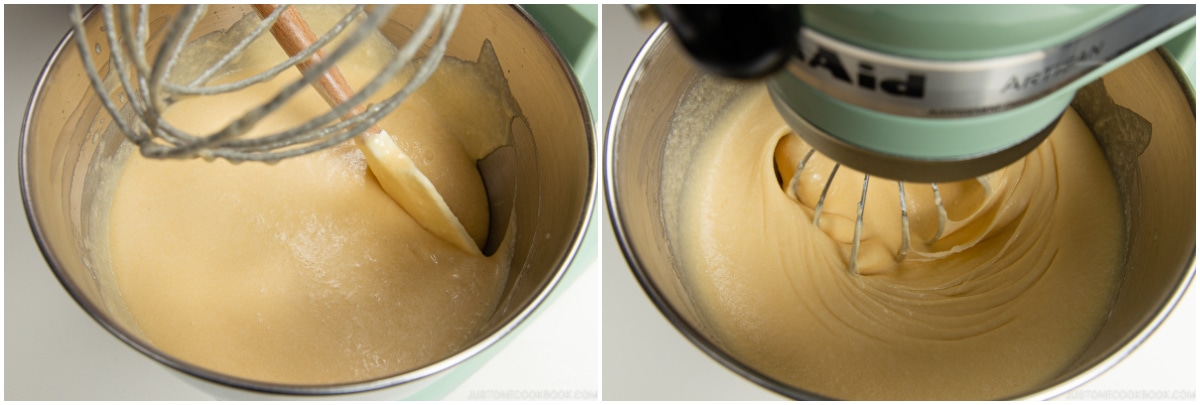
To Bake
- Pour the batter into the center of the prepared pan. Using the silicone spatula, draw a zigzag around the center of the pan to smooth out the batter. Tap the pan on the counter a couple of times to bring any air bubbles to the surface. Tip: If you don‘t smooth out the batter, the finished butter mochi may have a ripple mark or air bubbles on the surface. Note: If you like to add unsweetened coconut flakes, sprinkle them on top.
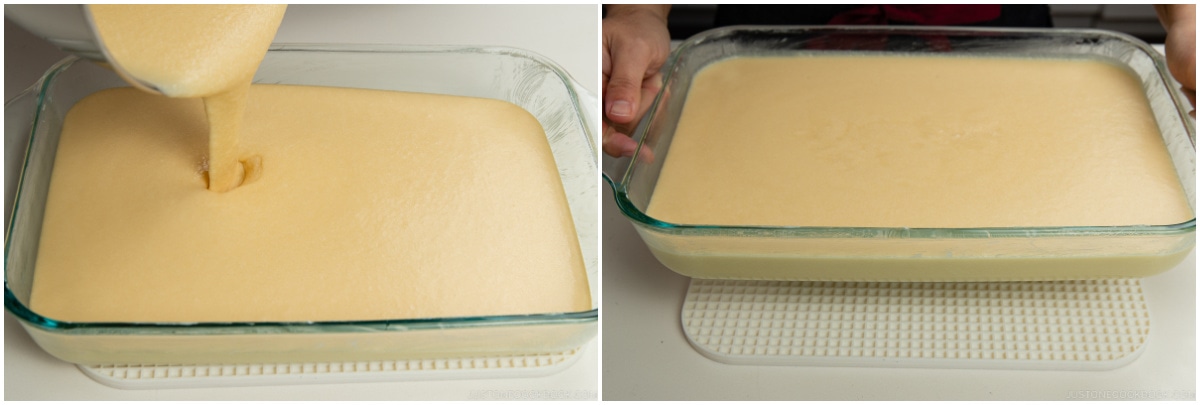
- Bake at 375ºF (190ºC) for 45 minutes, or until an inserted skewer comes out clean. The mochi should be set and golden brown on top.
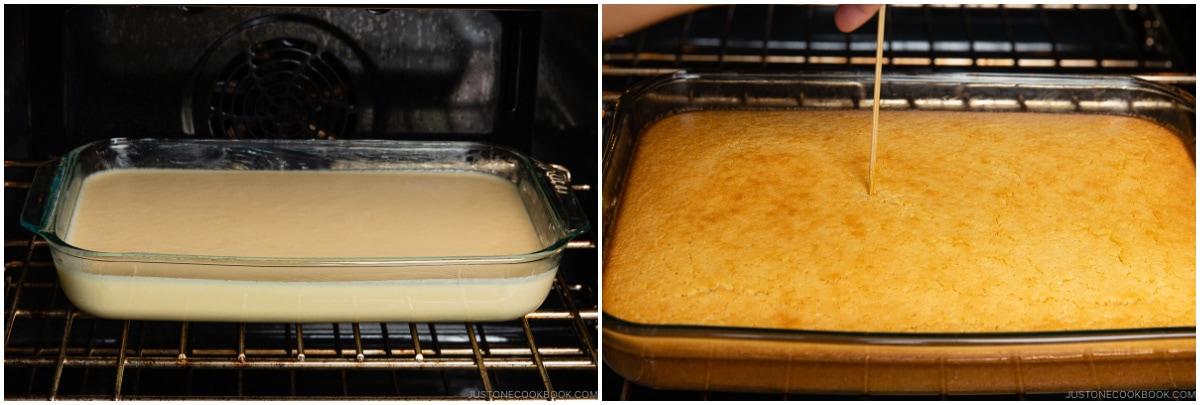
- Set the baking pan on a wire rack and let the butter mochi cool. You can either slice it into clean-cut pieces or serve it directly from the baking pan. To serve from the pan, leave it to cool completely on the wire rack for about 1 hour before slicing and serving. To slice clean pieces, let the mochi cake cool for 30 minutes. Remove it from the pan while it‘s still warm by running an offset spatula or butter knife along the edges to release it.
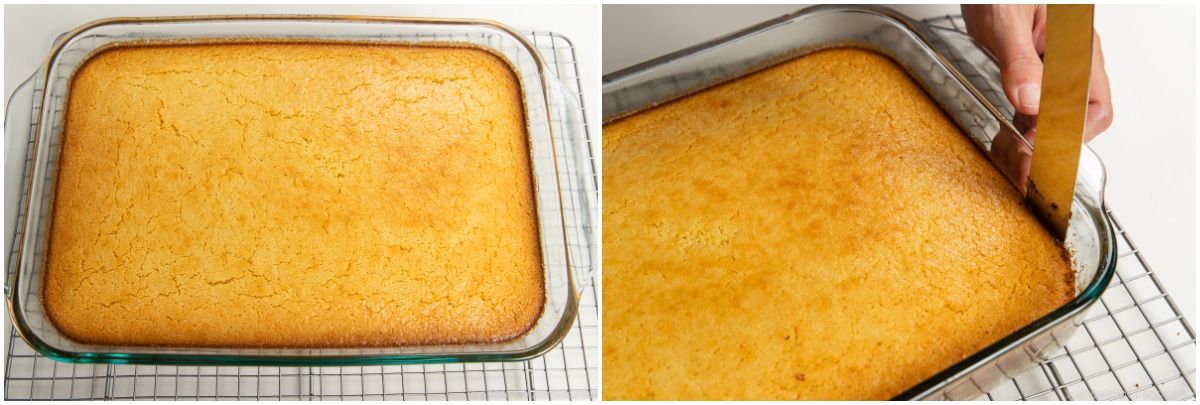
- Then, invert the butter mochi cake onto a tray or cookie sheet lined with parchment paper.
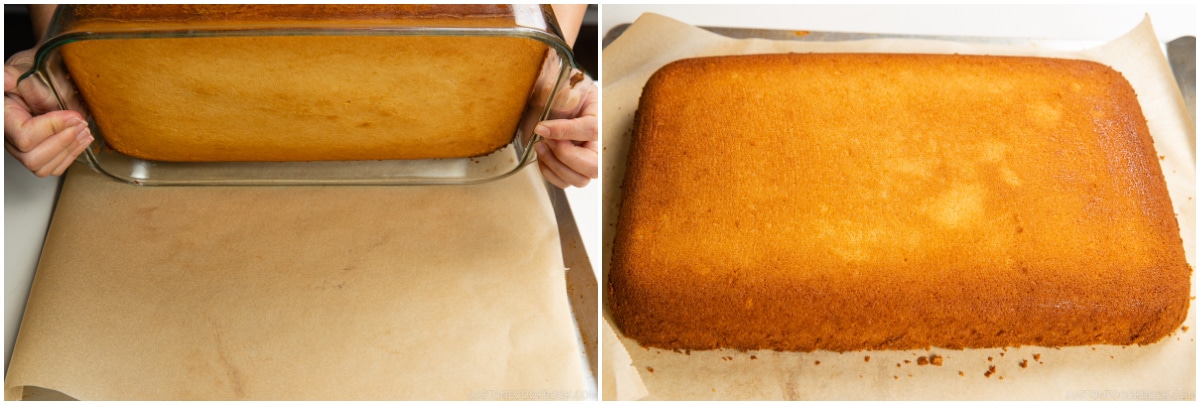
- Next, flip the butter mochi right side up: Place another sheet of parchment paper on top of the cake, followed by a cutting board. Then, hold the cookie sheet and the cutting board together, with the butter mochi sandwiched in between, and flip it over onto the cutting board. Remove the cookie sheet and parchment paper and save it for wrapping the butter mochi later.
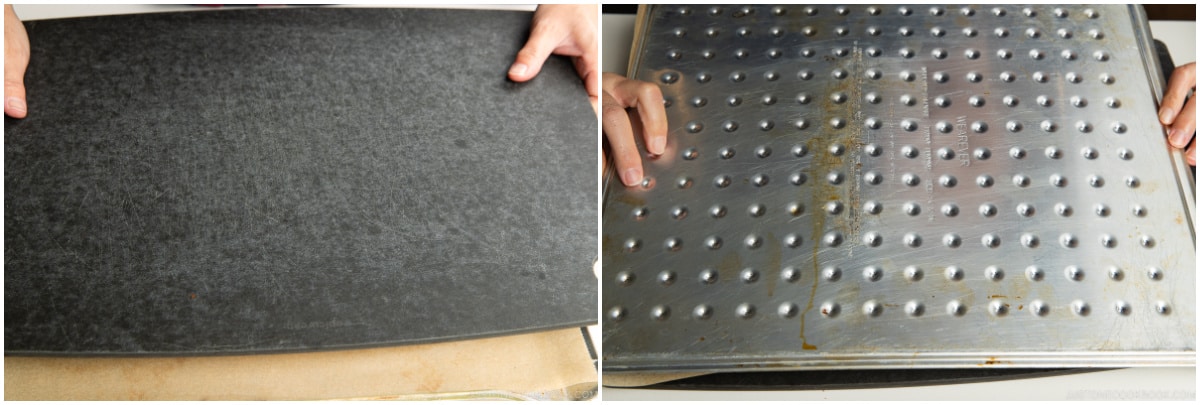
To Serve
- Slice the mochi cake into small pieces. I cut 6 columns and 4 rows from one 9 x 13-inch baking pan to make 24 pieces that are about 2 x 2 inches (5 x 5 cm). I read that a plastic knife won‘t stick to the butter mochi, but I don‘t have one, so I just rinsed my knife once halfway through slicing.
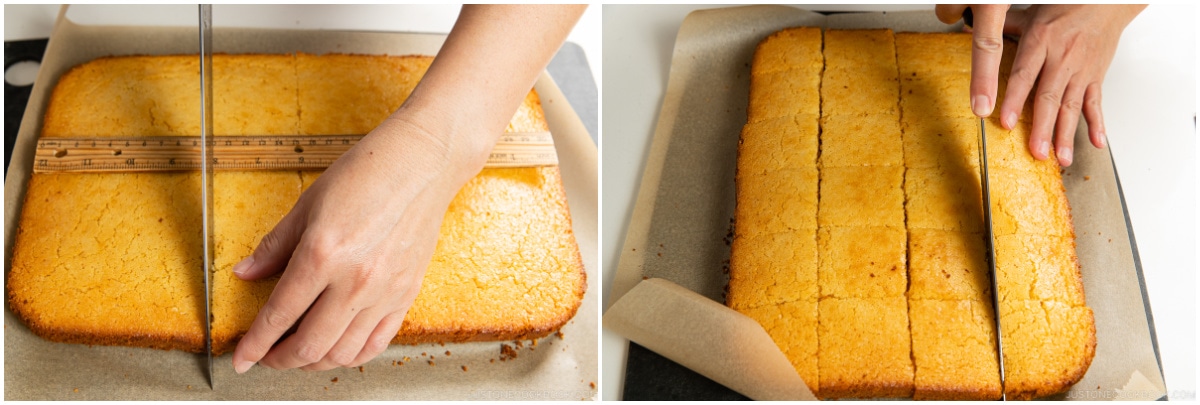
- I usually cut the 2 x 2-inch pieces in half because it‘s easier to eat. To keep them from sticking to each other, I separate each piece on the bottom and sides with small squares of parchment paper that I cut using the two sheets I repurposed from flipping over the butter mochi cake.
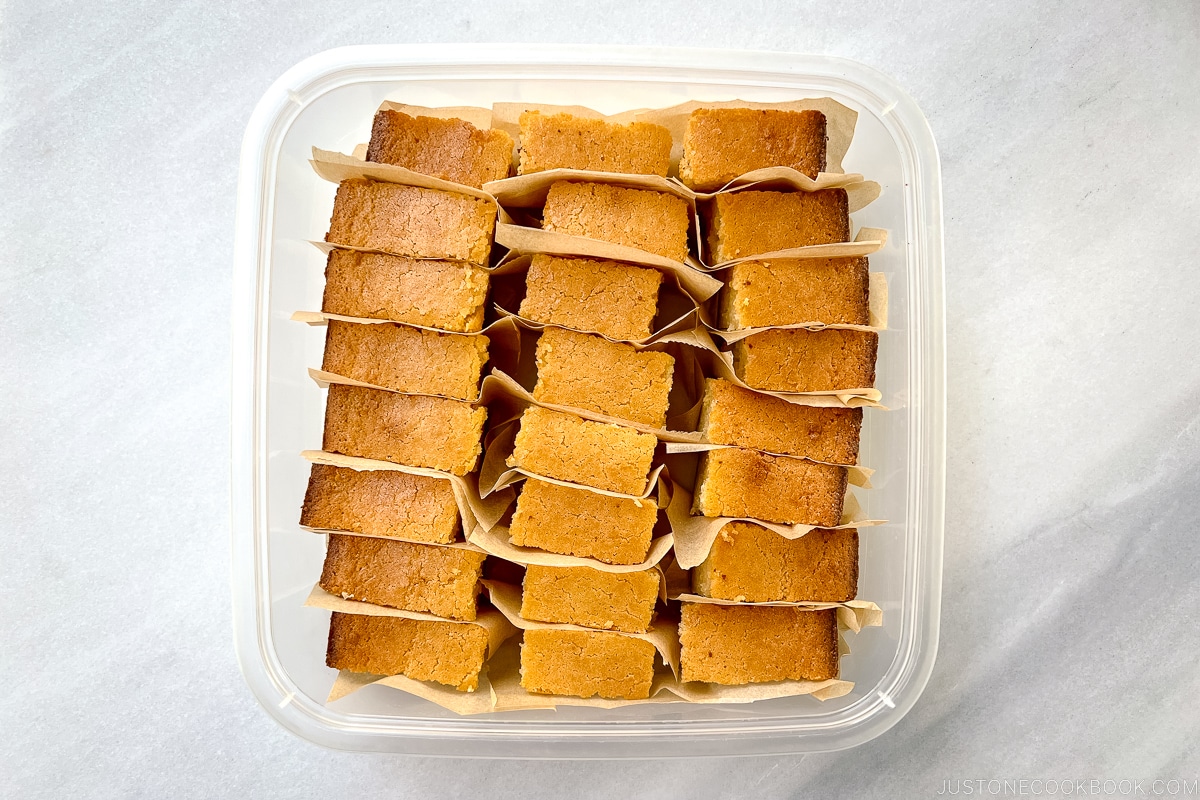
- Enjoy the butter mochi at room temperature. I personally like mine slightly warm, so I microwave it for 5–10 seconds before eating.
To Store
- Keep the butter mochi in an airtight container and store it at room temperature for up to 3 days. If you‘d like to keep it longer, wrap each piece (or the portion you will serve at one time) in plastic wrap to avoid freezer burn and drying out. Then, place them in a freezer bag or airtight container and freeze for up to 1 month. Thaw overnight in the refrigerator or at room temperature before serving. Serve at room temperature or heat in a microwave for 5–10 seconds, if you‘d like.
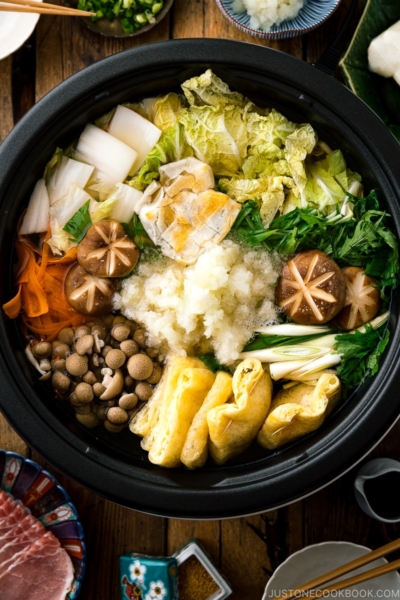
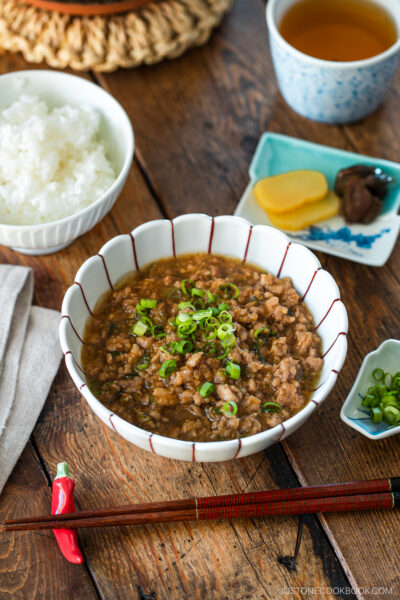
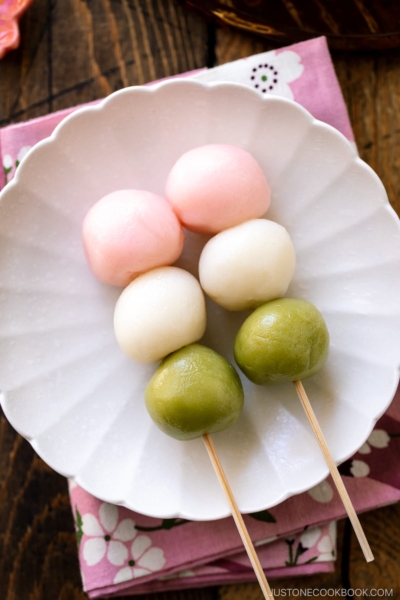
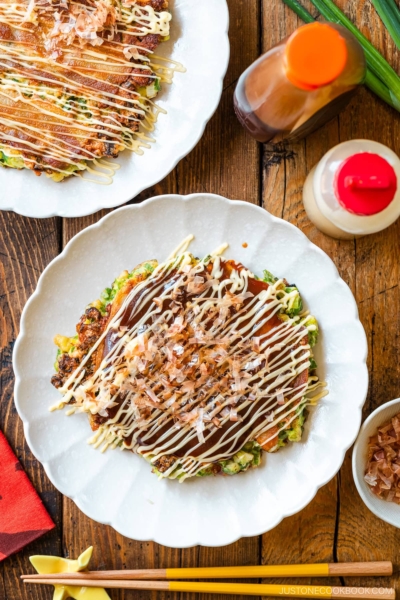




Omg! This is the best Hawaiian sweet butter mochi I’ve ever made!!
I used to buy boxes after boxes of Trader Joe’s limited Hawaiian sweet mochi every summer. It was always a hit with my family and colleagues.
And now, thanks to JOC, I can make twice more ( or triple) amount of this sweet goodie whenever I desire!
The crispy edges and the chewy center are all so heavenly.
Easy to follow, no tricks in the making, what more can I ask?!
Hello Kelly! Aww. We are happy to hear you enjoyed homemade Butter Mochi as much as we do!
Thank you for trying Nami’s recipe and sharing your experiences. Happy Baking!
Hello, do you think using Erawan glutinous rice flour instead of Mochiko is okay? I could not find Mochiko at my local Asian market.
Also thanks so much for all you do! I really enjoy all your recipes!
Hello Lucas! Thank you for trying Nami’s recipe.
You can use other types of glutinous rice flour, but using Erawan glutinous rice flour will make the Butter Mochi more sticky and dense. This is because Mochiko is made from short-grain Japanese rice, which is different from other types of rice.
We hope this information is helpful!
Can you make a matcha version?
Hi, Cynthia! Thank you for reading Nami’s post and trying out her recipe!
We have not created a Matcha version yet. You will need to use 2-4 tablespoons of matcha and milk instead of coconut milk. I will include it on the requested recipe list. I’m hoping Nami can work on the recipe sometime!😃
Finally made butter mochi today 🙂 I used only 250g brown sugar and flavoured half the batch with hojicha powder and chocolate because I am an incorrigible tinkerer. I was surprised to find that mochiko is quite hard to get here, even with a number of Japanese grocery stores around (I live in Sydney, Australia). I’ll just have to check out some more grocery stores, what a horrible fate 🙂
The recipe feels very easy to make, which is great! My butter mochi came out custardy and mochi-like more than cakey, and I like both plain and flavoured versions. Thank you for teaching me about a dish that I most likely never would have gotten to try otherwise!
Hello, Melionan. Thank you very much for exploring Nami’s recipe and sharing your results with us.
Hojicha and chocolate sound like a great combination!🤩
In terms of texture, brown sugar will make the dough moister during baking and may result in a more mochi-like texture.🙂
as a lover of red bean paste (Anko), I am wondering if it could be incorporated into this recipe?
Hello, Kathy. Thank you for taking the time to read Nami’s post!
We haven’t attempted it before, and we’re not sure how it will turn out, but it should work!
If you give it a try, please let us know how it goes!😊
Just a suggestion- When switching to metric view it would be nice to have things like salt expressed in grams As you know, Morton’s salt is unavailable in many parts of the country (Amazon cost is ridiculous) and Morton’s is what’s available. Because of the shape of the crystals, they aren’t comparable when using volume measurements such as teaspoons. But a gram is a gram is a gram.
Secondly, can this be made in a loaf pan? Same temperature for longer?
Thanks for all your wonderful recipes and the care you and Mr. JOC put into your video productions. You should be on PBS!
Hello, Michael! Thank you so much for taking the time to read Nami’s post and for your suggestion!
Yes, you can make this in a loaf pan and cook it for a little longer until the butter mochi is cooked through in the center.🙂
We hope you continue to enjoy many of our recipes! Happy cooking!
Thank you for this recipe! I made it for the first time and my husband loved it. It brought back happy memories of his mom making it during his childhood 🙂
Couple of questions: Mine came out very mochi-like and I noticed yours seems more cake-like. Do you think I just needed more cooking time? Also, it was my first time using coconut milk and the contents had separated. I just put it all in the mixer without shaking the can. Maybe this made a difference?
Also, I would like to freeze it for use in a couple of weeks. Is it better to cut individual pieces then freeze or can I freeze the entire block and cut after thawed?
Thank you so much! JOC is my go-to for all my Japanese recipes!
Here is my butter mochi!
Hi Annie! Thank you so much for trying Nami’s recipe and sharing your experience and photo of butter mochi!
To make the cake more cake-like, we recommend checking your baking powder first. When the can is opened for a while, the active ingredient begins to loosen up. So try a different baking powder or add a little more than the recipe calls for. When it comes to coconut milk, we recommend shaking the can before opening it to ensure that the coconut fat is well-mixed.
To save the cake, we recommend cutting it into separate pieces and freezing them in an airtight container or zip-lock bag. (Please check the note at the bottom of the recipe card for more information.)
We hope this information is helpful. Happy Baking!☺️
Thank you for all the great suggestions! I will try it and let you know how it turns out! ❤️
Awesome! Thank you for trying Nami’s recipes!🥰
How did it turn out?
Hi Nami,
I’m from Hawaii but live mainland side now. My recipe is more local-style, which means it’s more mochi-like than cake-like.
The ingredients are all the same, but I use salted butter and omit the added salt. It’s such a casual recipe that I’ve found that any brand of salted butter is fine. No one notices a difference.
For amounts, the changes are 2 tsp of baking powder, the sugar varies from 1 1/2 to 2 c depending on if I throw in additional ingredients like chocolate chips, dried pineapple, etc. My personal preference for a plain cake is 1 3/4 sugar. For the coconut milk, the can size doesn’t matter as different brands have different sizes. As long as it’s somewhere between 12-15 oz it will work. I use full fat Aroy-D or Thai Kitchen brands since they are highly rated on ATK. I increase the flavoring to 1 tbsp vanilla extract or vanilla bean paste.
My processing is very different though. I don’t use a mixer because even though you don’t get gluten, you do get air, which will make it very cakey and I want to have a little of the density of mochi but lightened up with the baking powder. So either a whisk, wooden spoon or a spoonula is used. I also try to use one bowl so clean up is easier since I don’t have a dishwasher!
Preheat oven to 350 degrees.
Grease 9×13 pan (preferably glass) with butter or non-stick spray.
In a large microwave-proof bowl, melt the butter 3/4 the way. Stir to melt completely.
Stir in sugar, then eggs one at a time, making sure there are no streaks left after any egg (a whisk is best for this job).
Add a can of milk (doesn’t matter which one), vanilla, 1 lb box mochiko, baking powder (I use a small sieve for the powder to prevent lumps).
Stir with spoon/spoonula until just moistened, then add remaining milk in 2 parts, stirring until no lumps remain.
Pour batter into pan. Bang pan on towel on the counter a couple of times to get out any air bubbles. Let it rest on counter while you wash up your utensils. (5 minutes) Bang pan on towel again to make sure there are no bubbles.
Bake 40-55 minutes until entire center is just puffed up. If edges brown too quickly, make a foil shield to cover edges only.
Let rest 15 minutes before cutting in pan. Let rest 25 minutes if you want to slide it out of pan onto a cutting board. If you greased your pan well, you should be able to run a small, thin metal spatula or knife around the edge and a larger one along the bottom then just slide the entire thing from the long side out in one piece without breakage. If you have fear, I’d do it the way you described. The parchment is definitely key or else you’d lose the crackly crust.
Thank you for posting your recipe. Even though my mother never made this (she was very old school from Kyushu), it’s nice to be remembered of home. 🙂
Hello, Salena! Thank you so much for reading Nami’s post and providing the local style Butter Mochi recipe!
We’ll give it a try the next time we make Butter Mochi. Thank you for taking the time to write this for us!
I make this recipe at least once a month. This time I made butter mochi flowers! 😄🌺
Hi Susan! Aww. That is so cute!
Thank you so much for sharing the idea! Happy Baking!🥰
Oops, I meant to give this recipe 5 stars, not 4! It’s such a convenient, easy dish that feeds a big crowd!
Absolutely delicious! This was my first time making the butter mochi. I made the 2 – 8″x8″ pans (one for me & my mom and one to bring to my brother’s family. My brother ended up liking it so much he told me I need to make it for Christmas and my mom and I had no problem polishing off an 8″x8″ pan in 3 days by ourselves. I listened to some of the other posts about the air bubbles being a problem and found that if I put a kitchen towel doubled up on the counter I could bang it harder which released more bubbles. It turned out beautifully.
Hello, Dani! Wow!🥰 We’re so glad you and your family loved Nami’s Butter Mochi recipe as much as we do!
Thank you so much for taking the time to share your Butter Mochi photo and experience with us. Your comment brightened our day!
LOVE this recipe! I did mochi cupcakes, and they turned out soooo good! I only did 1 and 1/4 cups of sugar and baked in silicone cupcake liners for 25 min. Thank you for this awesome recipe!
Hi Danielle! Thank you so much for trying Nami’s recipe and sharing your experience with us!
We are glad to hear you enjoyed the recipe. Happy Baking! 🤗
Nami! It worked beautifully! Thanks again for the recipe🥰
Hi Teng! Thank you! Nami is so happy to hear it worked very nicely!
Thank you for sharing the Butter Mochi photo. 🤩
This recipe was delicious! Thank you
(The picture wouldn’t attach the first time this is a second attempt
Hi Michael! Thank you so much for trying again to attached the photo!
It’s so nice to see everyone’s Butter Mochi. Happy Baking! 🥰